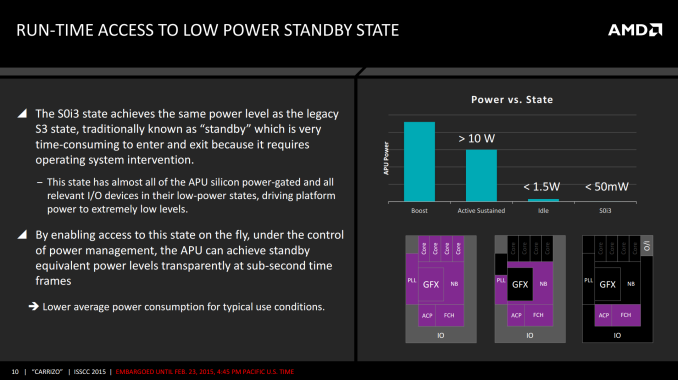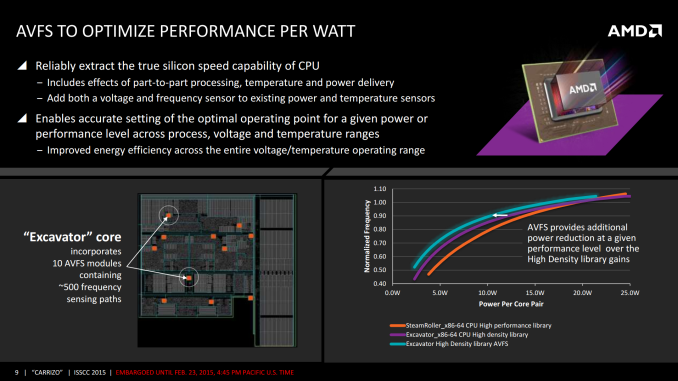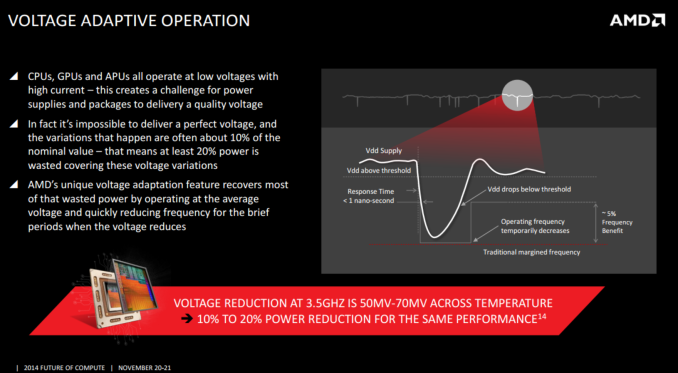AMD Launches Carrizo: The Laptop Leap of Efficiency and Architecture Updates
by Ian Cutress on June 2, 2015 9:00 PM ESTPower Saving and Power Consumption
When it comes to power, Carrizo features two/three technologies worth discussing. The first is the use of low power states, and the different frequency domains within the SoC. Previous designs had relatively few power planes, which left not as many chances for the SoC to power down areas not in use. Carrizo has ten power planes that can be controlled at run-time, allowing for what can be described as a dynamic race to sleep. This is bundled with access to the S0i3 power state, giving sub 50mW SoC power draw when in sleep and wake-up times under a second.
This is also combined with automated voltage/frequency sensors, of which an Excavator core has 10 each. These sensors take into consideration the instructions being processed, the temperature of the SoC, the quality of power delivery as well as the voltage and frequency at that point in order to relay information about how the system should adjust for the optimal power or performance point.
AMD states that this gives them the ability to adjust the frequency/power curve on a per-module basis further again to the right, providing another reduction in power or increase in frequency as required.
Next up for discussion is the voltage adaptive operation that was introduced back in Kaveri. I want to mention it here again because when it was first announced, I thought I understood it at a sufficient level in order to write about it. Well, having crossed another explanation of the feature by David Kanter, the reason for doing so clicked. I’m not going to steal his thunder, but I suggest you read his coverage to find out in more detail, but the concept is this:
When a processor does work, it draws power. The system has to be in a position to provide that power, and the system acts to restabilize the power while the processor is performing work. The work being done will cause the voltage across the processor to drop, to what we classically call Voltage Droop. As long as the droop does not cause the system to go below the minimum voltage required for operation, all is good. Voltage Droop works if the supply of power is consistent, although that cannot always be guaranteed – the CPU manufacturer does not have control over the quality of the motherboard, the power supply or the power conversion at hand. This causes a ripple in the quality of the power, and the CPU has to be able to cope with these ripples as these ripples, combined with a processor doing work, could cause the voltage to drop below the threshold.
The easiest way to cope is to put the voltage of the processor naturally higher, so it can withstand a bigger drop. This doesn’t work well in mobile, as more voltage results in a bigger power draw and a worse experience. There are other potential solutions which Kanter outlines in his piece.
AMD has tackled the problem is to get the processor to respond directly. When the voltage drops below a threshold value, the system will reduce the frequency and the voltage of the processor by around 5%, causing the work being done to slow down and not drain as much. At AMD’s Tech Day, they said this happens in as quickly as 3 cycles from detection, or in under a nanosecond. When the voltage drop is normalized (i.e. the power delivery is a more tolerable level), the frequency is cranked back up and work can continue at a normal rate.
Obviously the level of the threshold and the frequency drop will determine how much time is spent in this lower frequency state. We were told that with the settings used in Carrizo, the CPU hits this state less than 1% of the time, but it accounts for a sizeable chunk of overall average power reduction for a 3.5 GHz processor. This may sound odd, but it can make sense when you consider that the top 5% of the frequency is actually the most costly in terms of power than any other 5%. By removing that 5% extreme power draw, for a minimal performance loss (5% frequency loss for sub 1% of the time), it saves enough power to be worthwhile.













137 Comments
View All Comments
albert89 - Tuesday, June 23, 2015 - link
Most people are doing fine with an Intel atom, Celeron or Pentium with a dedicated GPU while most AMD APU's are over twice the horse power of the above and that's without a dedicated GPU ! Seriously........the 1366x768 issue was fixed a long time ago while Intel are still charging dinosaur CPU's at twice the price !Stuka87 - Tuesday, June 2, 2015 - link
Great article. Carrizo really looks promising. Looking forward to performance and power consumption numbers when the time comes.Refuge - Wednesday, June 3, 2015 - link
I'm trying not to get my hopes up too high, AMD has a history of over-promising, and under-delivering.But my 3rd gen APU is long in the teeth and I could use a new work laptop. If it is everything they say it will be, I expect to pickup a new Carrizo laptop this year, if I can find them that is.
monstercameron - Tuesday, June 2, 2015 - link
I believe the improvements to power use for video decode is called intra-frame power-gating, which makes sense seeing how the uvd engine can decode a video stream x times faster than realtime.fteoath64 - Wednesday, June 3, 2015 - link
This chip would be perfect for a HTPC serving 4K and below streams. Gives the Shield TV box a run for its money!. Go AMD.jjj - Tuesday, June 2, 2015 - link
lol another launch without reviews and they wonder why we'll all forget about their product by next week. Good or bad ,we would at least know what it is.SolMiester - Wednesday, June 3, 2015 - link
I agree...too many promises from this outfit, not enough action.FlushedBubblyJock - Tuesday, June 9, 2015 - link
everything is a secret, like bad governmentsbloodypulp - Wednesday, June 3, 2015 - link
Likely aligning reviews with Windows 10 launch. Soon.JDG1980 - Tuesday, June 2, 2015 - link
Carrizo looks promising, though I want to see actual benchmarks.AMD needs to bring the HEVC decoder to their discrete video cards (not just Fiji).